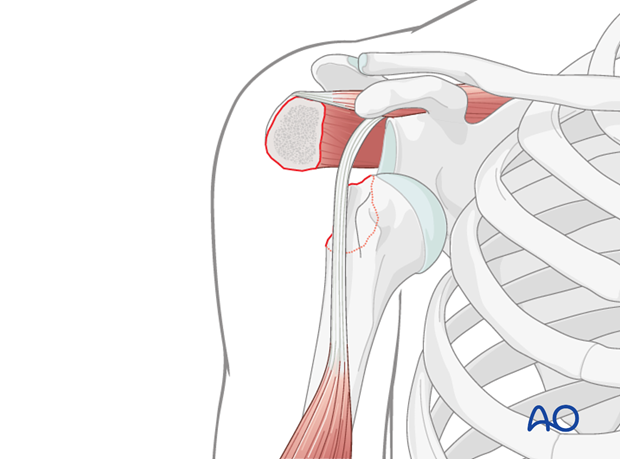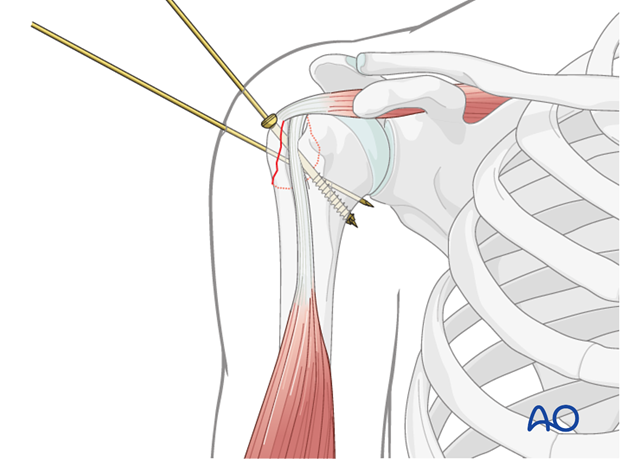MIO - Screw fixation
1. Treatment principles
Almost all of these fractures involve the greater tuberosity.
Reduction of the glenohumeral joint should be performed as an emergency procedure. Once the glenohumeral joint is reduced, the tuberosity fracture is treated as appropriate.
The greater tuberosity fragment tends to be displaced superiorly and posteriorly due to the pull of the rotator cuff (supraspinatus and infraspinatus tendon). If the greater tuberosity heals with displacement (5 mm or more), it may impinge upon the coracoacromial arch, limiting motion, and producing pain. In this position, it provides a shorter lever arm for the supra- and infraspinatus tendons, and thus weakens them.
The biceps tendon may be incarcerated in the fracture.

2. Patient preparation and approach
Patient preparation
This procedure is normally performed with the patient in a beach chair position.

Safe zones for screw insertion
Inserting percutaneous instrumentation through the safe zones reduces the risk of damage to neurovascular structures.

3. Reduction of the glenohumeral joint
Reduction of the glenohumeral joint should be performed as an emergency procedure.
There are various techniques to reduce the glenohumeral joint.
- Combined traction technique
- Modified Stimson technique
Unless reduction is carried out very soon after dislocation, analgesia or anesthesia are typically necessary. An initial attempt with conscious sedation may succeed. If not, general anesthesia with complete muscle relaxation may be required. If closed reduction is unsuccessful, open reduction may be necessary.
Combined traction technique
The patient is placed supine on a table. The injured arm is pulled longitudinally and, with the help of a second person, laterally as well.
A sheet around the chest may be used for counter-traction.

Modified Stimson technique
In the modified Stimson technique the patient is placed prone with the shoulder beyond the lateral edge of the table. A weight is attached to the wrist. Over time the musculature becomes fatigue and/or relaxed so that the humeral head reduces spontaneously, or with gentle manipulation.

Confirmation of reduction
The reduction is confirmed by x-ray. One should pay special attention to obtain a true AP view in order to confirm the glenohumeral reduction. Look carefully at the greater tuberosity, and determine its degree of displacement accurately.

4. Reduction and temporary fixation of the greater tuberosity
Reduction of the greater tuberosity
One can try to reduce the greater tuberosity closed, though this is unlikely to succeed. A manipulative reduction with a threaded pin through a stab incision under image intensification often works. If not, open reduction is required.
Closed reduction maneuver
In a slender patient, with the arm slightly abducted, it may be possible to press the greater tuberosity fragment into position with your thumb.

Direct reduction
Under image intensifier control, make a small stab incision over the lateral aspect of the greater tuberosity fragment. Spread the deltoid muscle gently and insert a small elevator, ball-spiked pusher, or hook. To reduce the greater tuberosity, apply the instrument to its upper border and …

… push it into its bed.

Temporary fixation of the greater tuberosity
Percutaneous reduction
The K-wire(s) is inserted while the reduction is maintained with the instrument.
Confirmation of reduction
Reduction and proper placement of the K-wire should be confirmed under image intensifier control.

5. Fixation of the greater tuberosity
It is the surgeons preference whether to use 3.5 mm cannulated lag screws (as illustrated) or small fragment screws.
Note: Washers might be advisable with osteoporosis or fragmentations. Generally, they are not preferable as they make the screw heads more prominent and may result in shoulder impingement.

Large fragments
If the greater tuberosity fragment is large, two screws may be used for better fixation.
Note: make sure to avoid the axillary nerve by placing the second screw rather proximal.

Completed osteosynthesis
Once osteosynthesis is completed remove all K-wires.
Check fixation by image intensification.

6. Overview of rehabilitation
The shoulder is perhaps the most challenging joint to rehabilitate both postoperatively and after conservative treatment. Early passive motion according to pain tolerance can usually be started after the first postoperative day - even following major reconstruction or prosthetic replacement. The program of rehabilitation has to be adjusted to the ability and expectations of the patient and the quality and stability of the repair. Poor purchase of screws in osteoporotic bone, concern about soft-tissue healing (eg tendons or ligaments) or other special conditions (eg percutaneous cannulated screw fixation without tension-absorbing sutures) may enforce delay in beginning passive motion, often performed by a physiotherapist.
The full exercise program progresses to protected active and then self-assisted exercises. The stretching and strengthening phases follow. The ultimate goal is to regain strength and full function.
Postoperative physiotherapy must be carefully supervised. Some surgeons choose to manage their patient’s rehabilitation without a separate therapist, but still recognize the importance of carefully instructing and monitoring their patient’s recovery.
Activities of daily living can generally be resumed while avoiding certain stresses on the shoulder. Mild pain and some restriction of movement should not interfere with this. The more severe the initial displacement of a fracture, and the older the patient, the greater will be the likelihood of some residual loss of motion.
Progress of physiotherapy and callus formation should be monitored regularly. If weakness is greater than expected or fails to improve, the possibility of a nerve injury or a rotator cuff tear must be considered.
With regard to loss of motion, closed manipulation of the joint under anesthesia, may be indicated, once healing is sufficiently advanced. However, the danger of fixation loosening, or of a new fracture, especially in elderly patients, should be kept in mind. Arthroscopic lysis of adhesions or even open release and manipulation may be considered under certain circumstances, especially in younger individuals.
Progressive exercises
Mechanical support should be provided until the patient is sufficiently comfortable to begin shoulder use, and/or the fracture is sufficiently consolidated that displacement is unlikely.
Once these goals have been achieved, rehabilitative exercises can begin to restore range of motion, strength, and function.
The three phases of nonoperative treatment are thus:
- Immobilization
- Passive/assisted range of motion
- Progressive resistance exercises
Immobilization should be maintained as short as possible and as long as necessary. Usually, immobilization is recommended for 2-3 weeks, followed by gentle range of motion exercises. Resistance exercises can generally be started at 6 weeks. Isometric exercises may begin earlier, depending upon the injury and its repair. If greater or lesser tuberosity fractures have been repaired, it is important not to stress the rotator cuff muscles until the tendon insertions are securely healed.

Special considerations
Glenohumeral dislocation: Use of a sling or sling-and-swath device, at least intermittently, is more comfortable for patients who have had an associated glenohumeral dislocation. Particularly during sleep, this may help avoid a redislocation.
Weight bearing: Neither weight bearing nor heavy lifting are recommended for the injured limb until healing is secure.
Implant removal: Implant removal is generally not necessary unless loosening or impingement occurs. Implant removal can be combined with a shoulder arthrolysis, if necessary.
Shoulder rehabilitation protocol
Generally, shoulder rehabilitation protocols can be divided into three phases. Gentle range of motion can often begin early without stressing fixation or soft-tissue repair. Gentle assisted motion can frequently begin within a few weeks, the exact time and restriction depends on the injury and the patient. Resistance exercises to build strength and endurance should be delayed until bone and soft-tissue healing is secure. The schedule may need to be adjusted for each patient.
Phase 1 (approximately first 3 weeks)
- Immobilization and/or support for 2-3 weeks
- Pendulum exercises
- Gently assisted motion
- Avoid external rotation for first 6 weeks
Phase 2 (approximately weeks 3-9)
If there is clinical evidence of healing and fragments move as a unit, and no displacement is visible on the x-ray, then:
- Active-assisted forward flexion and abduction
- Gentle functional use week 3-6 (no abduction against resistance)
- Gradually reduce assistance during motion from week 6 on
Phase 3 (approximately after week 9)
- Add isotonic, concentric, and eccentric strengthening exercises
- If there is bone healing but joint stiffness, then add passive stretching by physiotherapist













